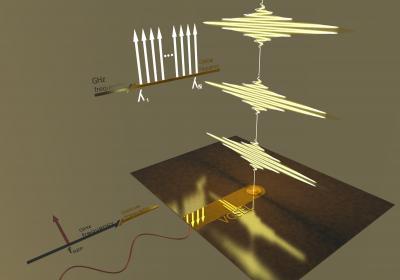This news release is available in Spanish.
Terahertz waves (THz) are found on the furthest extreme of the infrared band, just before the beginning of the microwave band. "This area is possibly the last range of the electromagnetic spectrum that is yet to be developed and exploited," comment the scientists. Although in recent years research has produced significant advances in the systems used to generate and detect this submillimetric radiation, it is still necessary to develop technologies with enough quality, flexibility and ease of use to cause an explosion in the commercialization of the THz range, points out Ángel Rubén Criado, one of the founding partners of Luz WaveLabs.
This company, a spin off hatched in UC3M's Department of Electronic Technology with the support of theVivero de Empresas (Business Incubator) in UC3M's Parque Científico (Science Park), is attempting to design high performance tools that can introduce THz waves to new sectors and convert this technology into an everyday tool within the next few years. Their star product is the "pure-T-wave", a THz generator that combines the advantages of electronics and photonics to obtain a "signal quality that is one million times greater than the one produced by the best photonic THz generator that is currently on the market," states the researcher.
Evolution of Nobel Prize winning technology
In order to do this, the researchers have used an "optic seed" (Optical Frequency Comb; OFC) of very high precision and coherence. This source of laser spectroscopy is similar to the one developed by John L. Hall and Theodor W. Hänsch (who won, thanks to this development, the Nobel Prize for Physics in 2005), although in this case the Spanish researchers have introduced a series of modifications that have allowed them to significantly reduce the device's cost, size and consumption. In fact, they recently published an article in Photonics Technology Letters about the most energy efficient OFC in the world.

Researchers at the Universidad Carlos III of Madrid and the firm Luz WaveLabs are developing an innovative Terahertz generator that improves signal quality by one million times as compared to the best device of this kind currently on the market; it will allow this technology to be applied in the areas of biomedicine, transportation safety, industry and radio astronomy, among others.
(Photo Credit: UC3M)
Building from this OFC source, the researchers combine radiofrequency and photonic electronic techniques to synthesize a very high quality THz signal. "The quality of the signal is so high that it has not been possible to measure some of the parameters with precision; they are higher than the measurement limits of our laboratory instruments," explains the researcher, who is currently working on the development of the commercial system. "Industrializing the laboratory prototype will be an important challenge; our objective is to provide a totally automated system that is easy for users with no specific training in this technology to operate," he notes.
Promising applications
The projected date for the market launch of this generator is the second trimester of 2015. The objective set by Luz WaveLabs is to create a device that is easy to use, allowing any type of user to employ this technology. The commercial systems that are currently available are much more oriented to scientists, who use them in their research; however, this innovation will be available for use by architects, doctors, and technicians controlling industrial processes, for example.
The characteristics of this type of radiation make this technology a very promising field of development for the coming years, according to the researchers. Because THz waves are harmless (non ionizing), they open the way for new, massive security systems in airports or stadiums. Their spectroscopic properties can be used in the detection of cancer and other diseases, as well as in the inspection from a distance, without causing damage, of metal and wooden structures (historical building), and hazardous materials in packages (transportation of merchandise), or the detection of invisible fractures or defects (factories). From a scientific perspective, the application that has given the greatest impulse to the development of THz waves is radio astronomy. "Since most black-body radiation and a large quantity of molecular and intermolecular resonances are located in the area of the THz waves, having powerful, high quality tools to work in this field will lead, in the future, to great advances in our understanding of the origin and function of the universe," he concludes.
Source: Carlos III University of Madrid